Important Stuff About Saxophone Reeds
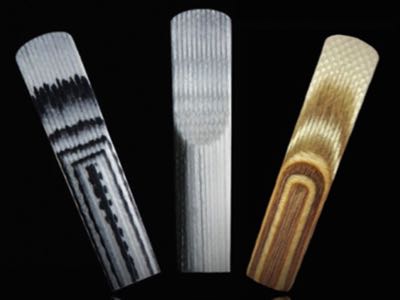
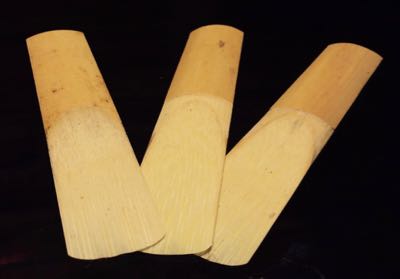
Reed Strengths
Here is how reed manufacturers label their reeds.
A cane reed’s strength is not dependent on the cane’s thickness, but rather a measure of resistance. So a reed that is labeled as a #2 is the same cut, or strength as one that’s labeled as a 3 or 4. The fact is that the higher the number, the more stiffer the material. In this case, the cane. In the case of a synthetic reed, they build up the amount, or layers of material. The more resistance it has, the harder it is to move the reed with our breathing, or air pressure.
Reeds come in different sizes, or more properly called strengths. Their Strength is measured by much resistance the reed has. This amount of resistance is labeled in terms such as Soft, medium soft, medium, medium hard, and hard. Most manufacturers label them by numbers starting with the number one as having the least amount of resistance.
This makes it the easiest to play. That is, the least amount of resistance which for you means the easiest to get a tone out of your sax for those first tries: one, one and a half, two, two and a half etc.
When you’re new to the sax and just starting out, a thin, or very soft reed is better than a thicker, or hard one to make the playing experience as easy as possible. A soft reed is easier to make a sound, the harder the reed the more difficult it will be.
So Why Even Try Using a Harder Reed?
Well, as we gain more playing experience, moving up from a 1 or 1.5 will help us get a better sound. No one with years of playing under their belt stays on a really soft reed such as a 1 or 1.5. But that doesn’t mean the harder the reed you play the better sound you will have.
As your embouchure strengthens you’ll be ready to try moving up to a half size stronger. It’s all a very personal and individual thing. There are famous pro’s that play on a 2 or a 2.5 reed. The number of the reed strength doesn’t equal your playing ability. You’ll move up slowly over the first couple years or so and finally settle on a size that remains as your preferred strength.
It can be a little like finding the right size shoes to buy… one type or brand may not be exactly like another and you may move up or down a half strength depending on the manufacturer or the material.
The Reed Must Be Wet
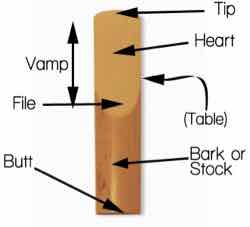 Never attempt to place your reed on the mouthpiece when it’s dry. This is a sure fire way to get squeaks. But also, a dry reed just won’t have the ability to perform as it should to help you produce your tone. You can let it sit in your mouth to soak up saliva, or you can let it sit in a glass of water for several minutes.
Never attempt to place your reed on the mouthpiece when it’s dry. This is a sure fire way to get squeaks. But also, a dry reed just won’t have the ability to perform as it should to help you produce your tone. You can let it sit in your mouth to soak up saliva, or you can let it sit in a glass of water for several minutes.
The water should cover the entire vamp of the reed up to the stock. When a reed dries out it will warp, so if you were to play it this way it wouldn’t work very well until the warping was gone. The warping will soon disappear once it’s wet and you play it for a minute or two. To prevent warping, place it in a reed guard or firmly down on a hard flat surface.
How To Tell If a Reed is Good or Bad
There are ways to tell this by visually inspecting it. The first thing to do is look a the center, or “heart” of the reed. It should be dark in color and actually be in the center of the reed. Since a reed is made from cane you will see grains running lengthwise. Things like inconsistency and discoloration in the grain may mean it’s not a good one. The heart should be in the center. Having said all this, it is possible that a reed will have inconsistent grain and a heart that’s not in the center and it still plays well.
Personally I don’t worry about the appearance, just slap it in place and it either plays or it doesn’t. I think that people got into looking at reeds when they bought them as singles out of a box of 20 or so. But stores don’t let you cherry pick them anymore so a visual inspection isn’t as important.
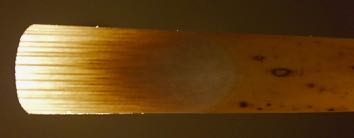
Heart of reed with grain lines
How Will I Know When To Change The Reed?
Natural cane reeds do have a life expectancy. It can be short or long depending on it’s quality and length of use. This amount of good playing time can be several days to several weeks or even months. This is where a more expensive premium reed may last longer. Most cane reeds will feel a bit stiff out of the box. Then after a bit of usage it will start to feel right. This feeling starts to change and it will almost suddenly become softer and weaker. The reed is now telling you it’s time has come.
Rotating Your Reeds
Some players will rotate a few reeds. This is a good idea because when your favorite reed dies you have another one that’s already broken in and ready to go. If not, you’ll be playing on a fresh out-of-the-box reed which may be stiff for a day or two.
Don’t Buy One or Two, Always Get a Box
Cane reeds are so inconsistent and unpredictable that you may only get a few good ones in box. Let’s say you only buy a few (some stores will break a box and sell singles) and the reeds are no good. You get home and your entire reed collection is terrible. But you don’t know they’re bad cause you’re just starting out. Now you blame yourself and feel awful and probably want to quit already!
Playing through an entire box of 10 or 20 you’ll start to feel the difference between the easier ones to play and the bad ones.
Start with a very soft reed, 1 1/2 and see how that feels. If it’s still hard to get a sound try a 1. Saxophone reeds are the type of thing that you need to decide for yourself, especially as you develop. There’s no such thing as the best reed in the world. What works perfectly for one won’t for another. There’s different variables for each of us like embouchure, mouthpiece tip openings etc.
You’ll eventually want to get several different brands and strengths and experiment to see what works best for you.
A Few of the Most Popular & Well-Known Saxophone Reed Brands
Below are a few of the top and most recognizable saxophone reeds. Most people, myself included would recommend the regular Rico reed for anyone that’s just starting to learn saxophone. They may not be the highest quality, but they’re consistent (as consistent as a cane reed can be) and good for playing at least till you develop a decent tone. To be honest, you don’t need to buy the most expensive reeds when starting out cause you won’t appreciate the difference anyway.
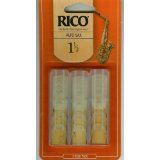 Rico
Rico
The Rico reed was the very first one I used. It’s probably the most famous brand and biggest reed manufacturer. I highly recommend any beginner to use a very soft Rico when starting out. By light I mean a 1, or 1 1/2. It’s best to have these two sizes handy so you can experiment as to which one feels the best to you. A bad or wrong reed strength can really impede your progress, especially during this beginning stage.
Rico has several choices such as Rico Royal, Rico Jazz Select, and D’Addario but just keep with the regular ones when starting out until you have started to get some control over your tone.
Just like the Rico brand, LaVoz has been around for as long as I can remember. I did use them for a bit but never stayed with them for too long although many guys I know love these reeds and use them. They’re quality reeds but I remember them not being as good right-out-of-the-box as the Rico’s where. That said, after they’re a bit worn-in they will probably have a longer life than the Rico’s.
These are the ones I use! I love these reeds but I don’t recommend them to everybody. While they are the best reeds I’ve ever tried on my Guardala mouthpiece, I wouldn’t necessarily keep using them if I changed to another mouthpiece. If you’re thinking about getting a Guardala mouthpiece you need to try these reeds, otherwise stick to one of the other brands, or another Vandoren V16, or ZZ’s. Vandoren makes quality reeds.
These are important and come in a variety of styles and brands. They work to protect your reeds because after being moistened and used they need to be held firmly on a hard, flat surface so they don’t warp.
These guards are basically just a hard flat surface with a way to firmly hold them down. You could make one out of a small piece of glass or hard flat piece of plastic and wrap a rubber band around them if you don’t want to spend the money. These are pretty cheap to buy though, the one pictured here is about $15 and there are smaller ones for around $5.
If you’re in Canada check Amazon.ca here
Synthetic Saxophone Reeds
As someone who has played on cane reeds for decades, the thought of being able to just pick up a reed and put it on the mouthpiece and have it respond perfectly everyday for months and months seems too good to be true. Fortunately this is a reality now that there are some very good synthetic reeds being made.
After dealing with the inconsistency and expense of cane reeds it’s a natural progression to at least look into, if not totally going with a synthetic. It’s a fact, sales are up because more and more players are doing this.
Synthetic reeds (some call them plastic) have come a long way in the last few years. Personally, I never could play one till only last year. There are more and more manufacturers getting into the game so that’s good for all of us. I truly believe that for a beginner, a good synthetic reed is the way to go. You’ll be assured of a consistent, reliable reed every day.
With inexperience and just starting on the saxophone there are just too many other variable to deal with. So if you can take care of one of the biggest problems we have when it comes to playing sax, by all means do it!
What Are Synthetic Saxophone Reeds Made From?
We all know natural reeds are made from cane, but what about the synthetic ones? All manufacturers of these reeds are attempting to mimic a cane reed in their products and each of them have their own way of doing this with a variety of materials. Polymer compounds are used, both natural and synthetic ones.
Natural polymers can be made from silk, wool, paper, wood fibers and even natural rubber. Plastic polymers derived from chemical compounds are also used. These types of polymers are not exclusive to the reed industry, they are used in making cars, plastic parts, carpets and many other products we use everyday.
Synthetic Reeds for the Total Beginner?
If you’re literally just starting to play the sax then the best thing you can do is have a soft synthetic reed. If you are staring out and happen to have a few new cane reeds and they all suck, then you don’t know if the reason you can’t get a sound is because of you or your reed.
A box of regular cane reeds can have 10 or 20 reeds in it. That in no way means they will all be good. A few will be very good, a few will be ok, a few will go right into the trash, unless you’re willing to work on them. This is one of the problem with traditional reeds.
Working on Reeds to Make Them Play Better
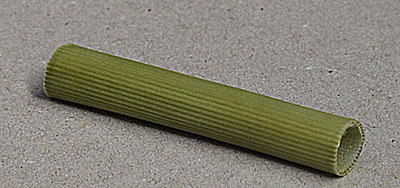
reed rush
Yes, we can work on reeds to make them play better, whether they’re cane or synthetic.
Reed Rush is a natural product that has been around for many decades., This is a natural plant found near water.
It has rib-like edges and when it dries out from it’s normal living green state it becomes hard enough to wear down the reed. This will only work on cane reeds.
You can also use fine sand paper to shave down a reed. There is also a tool you can buy called The Reed Geek which also works well on synthetic reeds.
What Are Some Of The Synthetic Reed Brand Names?
Rico started with a “plastic covered” reed way back in the 1980’s, at least that’s the first time I tried one. These were not a full synthetic reed, but a regular cane one covered with a thin black plastic coating. The idea was to give it an extra layer of protection and make it last longer.

Rico Plasticover Saxophone Reed
They felt good from what I remember but the problem I had with them was that they’d split very easily when I screamed a lot in the altissimo register so I had to give them up. I wasn’t going to give up my altissimo notes!
Fiberreed – these are the brand I was attracted to the most and am currently using. There are 4 different reed types from Fiberreed:
- Natural
- Carbon
- Hemp
- Onyx
Check out the comparison of these reeds in the video below:
Legere – made in Canada and was the first 100% synthetic reed I heard about and tried. I suppose most of my sound was still there but it just felt weird to play so I never did use it after one day of trying it out. To be fair, this was a few years ago and I know they have more models now which are most likely an improvement over the one I played which is the Studio Cut.
- Classic (Studio Cut)
- Signature
Check out the Legere vs Vandoren cane in the video below:
Forestone – these are newer and I have yet to try them. They’re a white bamboo synthetic reed made from polypropylene resin and cellulose wood fibre.
Bravo – American made as well. These are sold differently than other brands since they come in a box of 5, whereas all the others are sold individually. Bravo’s box of 5 reeds cost about the same as one of the other brand’s single premium reeds.
Bari – I believe this is the same company who makes mouthpieces as well. Had a Bari plastic mouthpiece on my baritone sax many years ago and loved it. The reeds are much cheaper in price than most other brands and only come in one model.
Fibracell – is another top name and comes from the USA. These worked better for me but it was still hit and miss depending on the mouthpiece and even the day.
Check out my Fibracell vs Fiberreed comparison video here: Fibracell vs Fiberreed

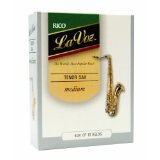




Johnny: You and I have gone over the reed deal before. I am playing the Onyx now. S and MS. I did sand the tip of the Soft. It plays real well now that I firmed it up some. Do you have a stock of Hemps? If so, I would like to order one. There is a site in SO CAL that sell Hartman. Left a message. I hope they get back? Please let me know. Oh, I do have Legeres also. I like the Carbons better. Rotation is the right thing to do. One does not wear them out so fast. Another great info piece from you. Thanks. Tim
The first reed I reach for is the Carbon Onyx soft reed. Sometimes I’ll stick a medium soft Onyx on my mouthpiece, but the Carbon Onyx soft reed is my favorite. The carbon onyx reed is always ready, no soaking or trimming. Just stick it on and I’m ready to go. They sound great, even in the subtones and higher on up the scale to high F#. I have a couple of black bamboo reeds but the Onyx reed sounds better. I have two of those black protec reed cases. One case for soft Onyx reeds and and medium soft hemp reeds and the 2nd case for medium soft Onyx reeds and medium hemp reeds. I have loads of cane reeds but Carbon onyx is my reed.
ya Tim the guy in so cal is Dannie, he’s the US rep distributor for Fiberreed. I know him well, nice guy.
I’m with you William. speaking of the Onyx…I just realized it’s been almost 1 year that I started using mine. will have to do a video update on how it’s doin, lasting etc.
Ya, I talked to Dannie today. The Hemps are on the way. Thanks. Tim
Hi Johnny I liked the Java sound whereas the Legere seems a bit to classic. I would have liked to have heard the Signature or the Fibracell on your mouthpiece but I understand that it would be to time-consuming to hear them all. The article was very informative and I do like the Fiberreed Onyx reeds you have suggested. I have ordered more Onyx and have ordered a Hemp to try on the Theo Wanne Durga mouthpiece. I do like the Onyx on my alto but would have liked a bit stronger version the last one played for a good length of time but the tip shattered eventually so i went back to the cane as i did not have a spare. I recommend alternating between using cane and synthetic at gigs which gives a unique feeling to your playing (at least for me it does).
don’t think I’ll be getting a signature cause didn’t like the studio cut but I do have a Fibracell and was thinking of doing a video test/comparison with it. hopefully real soon and you’ll see it on the post above.
Hey Johnny, Great article. I’ve been pleased that you’ve opened up to synthetic reeds. I swore off cane reeds years ago out of frustration. The first synthetics I played were Fibracell and got tired of the buzzy sound to my ear. I’ve played LeGeres for a number of years, signature and studio cut, with reasonable results. I switched to Forestone 2 years ago and like them very much. The Black Bamboo sounds better on my hard rubber Wanne and Mouthpiece Cafe. The Hinoki sounds great on my metal Wanne. I recently bought a Fiberreed Hemp based on your articles. I need to spend some time with it to have a complete opinion. I think players with an open mind who are willing to spend some time on synthetics will get to a point where cane will no longer make sense.
Hi Johnny,
I’m a little older than you (almost 80), and have been the same reed route as you have…. regular Rico, Plasticovers, and many others. Excellent reed review.
My first full synthetic was a Bari soft…. It was great – played it for 2 years. It even played well when I chipped/bent the tip and also with a split. I could not get a similar Bari reed after that, so my search for others began. Fibracells ,etc., which were also very good.
I tried the regular Legere and didn’t like it at all. But their Signature model is a different animal – excellent (for me). I purchased a few of the Naturals and Hemps and didn’t like them either. BUT, their black Onyx is a jewel. I play monster tip openings and this reed responds (just as the Legere Signature did) well to most every size mp that I have (.115 through .185).
I do also have a collection on Vandoren Javas that I like also. They’re a different, but nice feel than the synthetics. But why mess with cane just to start all over with another one in a couple of weeks? The synthetics work RIGHT NOW, the SAME WAY for what seems like forever. If they don’t, it’s usually me or a sax tweak need.
It seems that I’m not alone. All of the comments seem to be saying the same thing.
Thanks for your reviews.
Great Article, all the professional classical sax players that i’ve met, that play in orchestra’s wouldn’t touch synthetic reeds with a barge pole. I guess they don’t have an open mind. Either way i’m not convinced, i’ll stick to my reeds.
Ive been playing on Bari reeds forever. Love the fact that they are always the same whenever wherever! .Also been playing on a Bari Hybrid mouthpiece 8* which has been working well for me with a medium reed (3-3,5) Have just picked up a fat boy from Johnny which is more open and a bit of a struggle on a medium reed , so will try on a bari med soft(2.5-3) Let you know how I go!
Use a Bari medium reed for years, but have recently gone back to cane and using a Van Doren Java 2.5 . A great reed for me.
A recent article in Woodwinds & Brasswinds prompted me to try the Legere. I must say i like it better than the onyx on my Selmer MK VI tenor with Otto Link NY